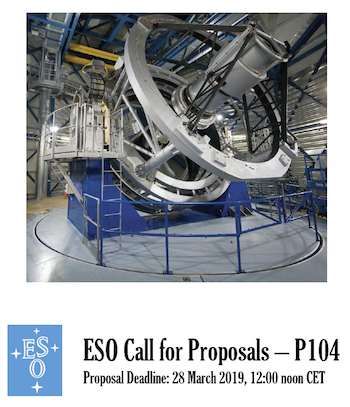The Call for Proposals for observations at ESO telescopes in Period 104 (1 October 2019 – 31 March 2020) has been released. Please consult the Period 104 document for the main news items and policies related to applying for time on ESO telescopes. All technical information about the offered instruments and facilities is contained on ESO webpages that are linked from the Call. The proposal submission deadline is 12:00 CET 28 March 2019.
Call for Proposals for Period 104
Published: 28 Feb 2019

Here we summarise some of the important changes for Period 104:
- As previously announced, starting from Period 104, Large Programme proposals will only be accepted once per year during even Periods. Large Programme observations can start in either Period 104 or Period 105, but can only extend up to Period 107 at most.
- New Large and Monitoring Programmes are offered on VLTI using either the ATs or the UTs for GRAVITY, MATISSE and PIONIER.
- Normal, Monitoring and Large Programme proposals will be accepted for OmegaCAM and VIRCAM without restrictions on atmospheric conditions, lunar phase or RA range. Both instruments are expected to be scheduled until Period 107.
- Large Programmes are not offered for EFOSC2 or SOFI since these instruments are expected to be decommissioned in upcoming periods for the installation of SOXS.
- NACO and SINFONI will be decommissioned in Period 103 and are therefore not offered.
- VISIR is offered with restrictions on the Cassegrain focus of UT4 during the first half of Period 104. It is expected to be back at the Cassegrain focus of UT3, with all functionalities, during the second half of Period 104, following its use for the New Earths in the Alpha Cen Region (NEAR) experiment on UT4.
- The visitor focus of the 3.6-metre telescope is not offered during Period 104 due to the installation and commissioning of NIRPS. The Nasmyth A focus of UT1 is available as of mid-November 2019 for a Visitor Instrument, while the Cassegrain focus of UT3 will be available during the first half of Period 104.
- Starting in Period 104, new users needing assistance to prepare VLTI proposals can request in-depth support from the community supported VLTI Expertise Centres. VLTI observations need to select one or more of the following types: snapshot, time-series, imaging, astrometry. See Sect. 2.3.1 of the Call document for further details. AT configurations should be requested by the names "Small", "Medium", "Large", or "Astrometric", rather than explicit configurations. The configurations used for a given period are detailed in the VLTI Configurations Overview webpage and should be used for Phase 1 and Phase 2 preparation.
- To allow longer Normal Programmes for PI230 at APEX, especially programmes that do not require the best weather conditions, the maximum length of Normal Programmes - only for this instrument - has been raised to 199 hours. See Section 1.1 of the Call document for further instructions on submitting PI230 proposals requesting between 100 and 199 hours.
